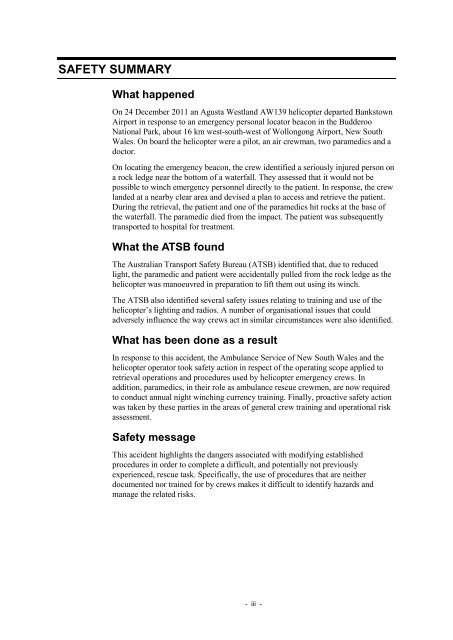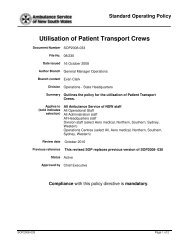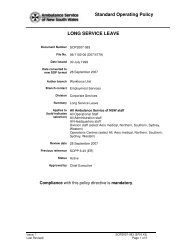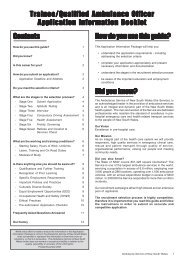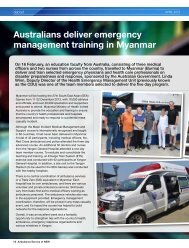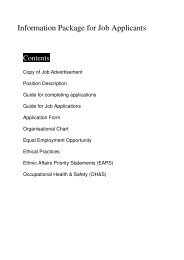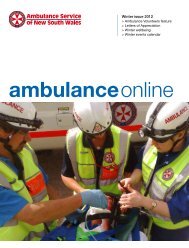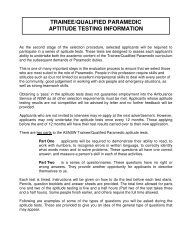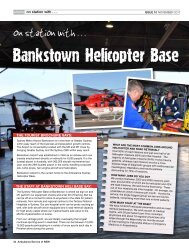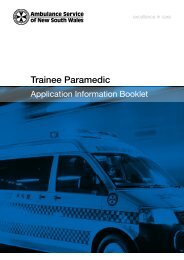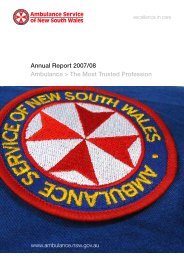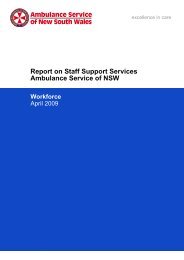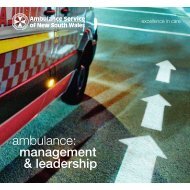atsb final report released 16 may 2013 - Ambulance Service of NSW
atsb final report released 16 may 2013 - Ambulance Service of NSW
atsb final report released 16 may 2013 - Ambulance Service of NSW
You also want an ePaper? Increase the reach of your titles
YUMPU automatically turns print PDFs into web optimized ePapers that Google loves.
SAFETY SUMMARYWhat happenedOn 24 December 2011 an Agusta Westland AW139 helicopter departed BankstownAirport in response to an emergency personal locator beacon in the BudderooNational Park, about <strong>16</strong> km west-south-west <strong>of</strong> Wollongong Airport, New SouthWales. On board the helicopter were a pilot, an air crewman, two paramedics and adoctor.On locating the emergency beacon, the crew identified a seriously injured person ona rock ledge near the bottom <strong>of</strong> a waterfall. They assessed that it would not bepossible to winch emergency personnel directly to the patient. In response, the crewlanded at a nearby clear area and devised a plan to access and retrieve the patient.During the retrieval, the patient and one <strong>of</strong> the paramedics hit rocks at the base <strong>of</strong>the waterfall. The paramedic died from the impact. The patient was subsequentlytransported to hospital for treatment.What the ATSB foundThe Australian Transport Safety Bureau (ATSB) identified that, due to reducedlight, the paramedic and patient were accidentally pulled from the rock ledge as thehelicopter was manoeuvred in preparation to lift them out using its winch.The ATSB also identified several safety issues relating to training and use <strong>of</strong> thehelicopter’s lighting and radios. A number <strong>of</strong> organisational issues that couldadversely influence the way crews act in similar circumstances were also identified.What has been done as a resultIn response to this accident, the <strong>Ambulance</strong> <strong>Service</strong> <strong>of</strong> New South Wales and thehelicopter operator took safety action in respect <strong>of</strong> the operating scope applied toretrieval operations and procedures used by helicopter emergency crews. Inaddition, paramedics, in their role as ambulance rescue crewmen, are now requiredto conduct annual night winching currency training. Finally, proactive safety actionwas taken by these parties in the areas <strong>of</strong> general crew training and operational riskassessment.Safety messageThis accident highlights the dangers associated with modifying establishedprocedures in order to complete a difficult, and potentially not previouslyexperienced, rescue task. Specifically, the use <strong>of</strong> procedures that are neitherdocumented nor trained for by crews makes it difficult to identify hazards andmanage the related risks.- iii -


